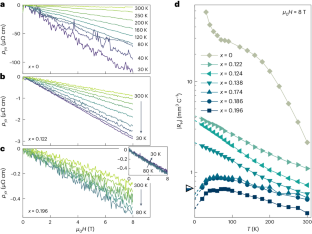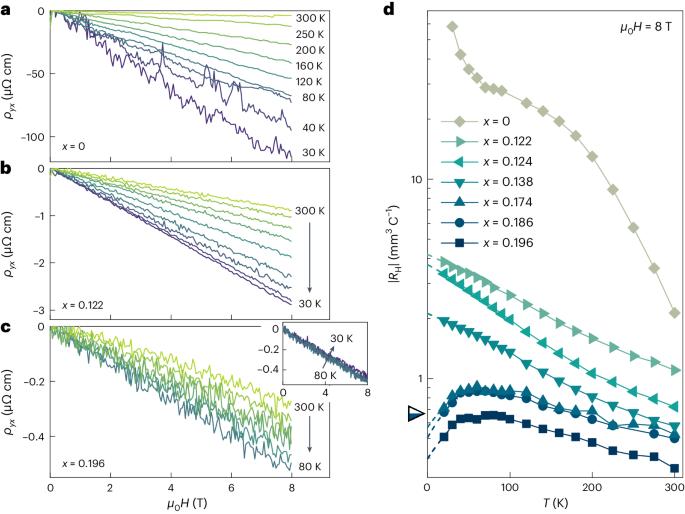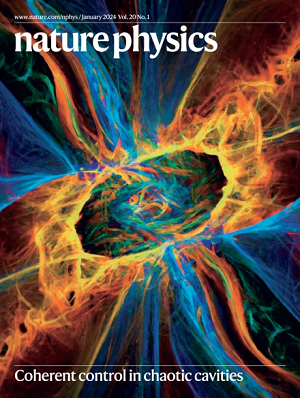Carrier density crossover and quasiparticle mass enhancement in a doped 5d Mott insulator
IF 17.6
1区 物理与天体物理
Q1 PHYSICS, MULTIDISCIPLINARY
引用次数: 0
Abstract
High-temperature superconductivity in cuprates emerges upon doping the parent Mott insulator. Key features of the low-doped cuprate superconductors include an effective carrier density that tracks the number of doped holes, the emergence of an anisotropic pseudogap that is characterized by disconnected Fermi arcs and the closure of the gap at a critical doping level. In Sr2IrO4, a spin–orbit-coupled Mott insulator often regarded as a 5d analogue of the cuprates, surface probes have also revealed the emergence of an anisotropic pseudogap and Fermi arcs under electron doping. However, neither the corresponding critical doping nor the bulk signatures of pseudogap closure have yet been observed. Here we demonstrate that electron-doped Sr2IrO4 exhibits a critical doping level with a marked crossover in the effective carrier density at low temperatures. This is accompanied by a five-orders-of-magnitude increase in conductivity and a sixfold enhancement in the electronic specific heat. These collective findings resemble the bulk pseudogap phenomenology in cuprates. However, given that electron-doped Sr2IrO4 is non-superconducting, it suggests that the pseudogap may not be a state of precursor pairing. Therefore, our results narrow the search for the key ingredient underpinning the formation of the superconducting condensate in doped Mott insulators. The pseudogap in cuprates is often linked to superconductivity. Now bulk evidence for a pseudogap is found in doped non-superconducting Sr2IrO4, revealing that pseudogaps in doped Mott insulators are not necessarily a precursor to superconductivity.


掺杂 5d 莫特绝缘体中的载流子密度交叉和准粒子质量增强
掺杂母莫特绝缘体后,杯状化合物中会出现高温超导现象。低掺杂铜氧化物超导体的主要特征包括:有效载流子密度与掺杂空穴的数量成正比;出现以费米弧断开为特征的各向异性伪间隙;以及在临界掺杂水平上间隙的闭合。在通常被视为铜氧化物 5d 类似物的自旋轨道耦合莫特绝缘体 Sr2IrO4 中,表面探测也揭示了电子掺杂下各向异性伪间隙和费米弧的出现。然而,我们尚未观察到相应的临界掺杂和伪间隙关闭的体征。在这里,我们证明了电子掺杂的 Sr2IrO4 在临界掺杂水平上表现出低温下有效载流子密度的明显交叉。与此同时,电导率增加了五个数量级,电子比热提高了六倍。这些集体发现类似于铜氧化物中的体伪隙现象。然而,鉴于电子掺杂的 Sr2IrO4 是非超导的,这表明伪间隙可能不是一种前驱体配对状态。因此,我们的研究结果缩小了在掺杂莫特绝缘体中寻找形成超导凝聚态关键成分的范围。
本文章由计算机程序翻译,如有差异,请以英文原文为准。
求助全文
约1分钟内获得全文
求助全文
来源期刊

Nature Physics
物理-物理:综合
CiteScore
30.40
自引率
2.00%
发文量
349
审稿时长
4-8 weeks
期刊介绍:
Nature Physics is dedicated to publishing top-tier original research in physics with a fair and rigorous review process. It provides high visibility and access to a broad readership, maintaining high standards in copy editing and production, ensuring rapid publication, and maintaining independence from academic societies and other vested interests.
The journal presents two main research paper formats: Letters and Articles. Alongside primary research, Nature Physics serves as a central source for valuable information within the physics community through Review Articles, News & Views, Research Highlights covering crucial developments across the physics literature, Commentaries, Book Reviews, and Correspondence.
 求助内容:
求助内容: 应助结果提醒方式:
应助结果提醒方式:


